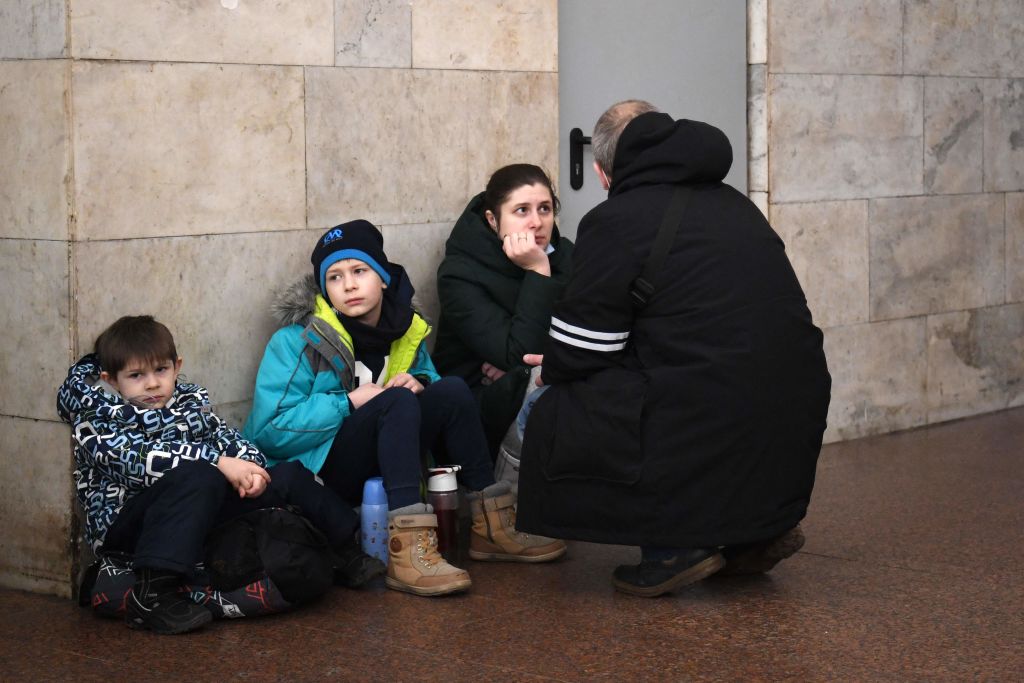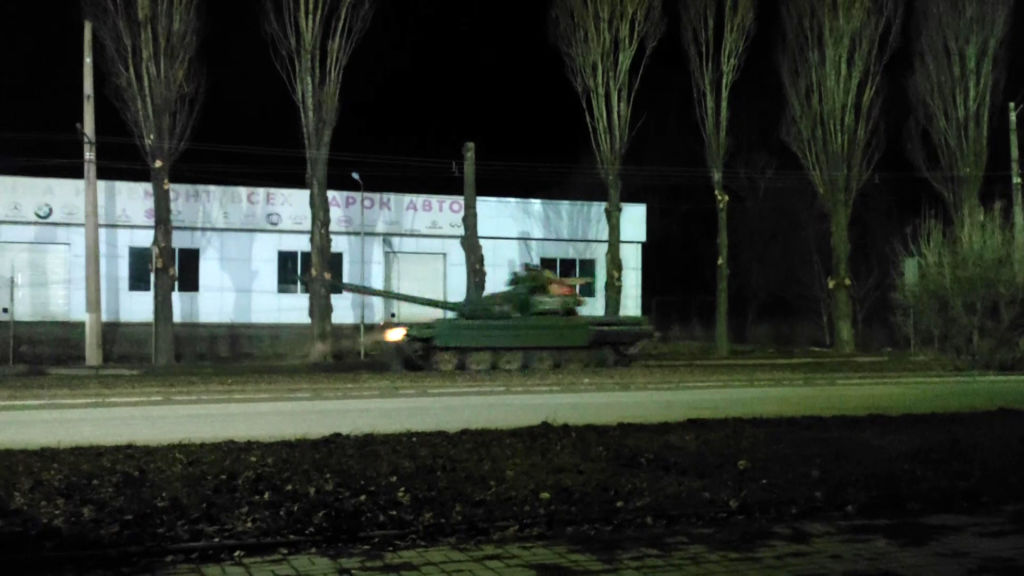The Russian military launched a multi-pronged assault on cities throughout Ukraine early Thursday morning, defying months of diplomatic efforts by the U.S. and its allies to deter the invasion, and triggering the greatest military crisis on the European continent since the Cold War. U.S. President Joe Biden denounced the attacks as “unprovoked and unjustified” and said, “The world will hold Russia accountable.”

Beginning in the predawn hours, explosions struck Kyiv, the Ukrainian capital, and other major cities as air raid sirens rang out. Cruise missiles hit airfields, military depots and the headquarters of the Ukrainian armed forces in the east of the country, according to the country’s Interior Ministry. U.S. officials believe the air attacks were the first facet of a phased operation that would be followed up by a ground invasion involving more than 150,000 Russian forces that have been amassing on Ukraine’s borders since late last year.
Read More: What to Know About Russia’s Military Operations in Ukraine
The large-scale military action began immediately after Russian President Vladimir Putin announced the start of a “special military operation” with the goal of executing a “demilitarization” of Ukraine, suggesting that Moscow did not intend to stop until the country’s armed forces had capitulated. That would mark the end of Ukraine’s post-Soviet independence and its three decades as a fledgling democracy, one in which Putin’s longtime allies still hold seats in parliament.

In his statement announcing the invasion Thursday, Putin warned against any efforts to deter Moscow’s forces. “Anyone who tries to interfere with us, or even more so, to create threats for our country and our people, must know that Russia’s response will be immediate and will lead you to such consequences as you have never before experienced in your history,” Putin said. “We are ready for any turn of events.”
Now that the Russian military operation in Ukraine has begun, there are looming fears about the risks that come with it for the rest of Europe and the world. Over the last several weeks, the U.S. and European allies have moved troops, naval ships and warplanes eastward on the continent, near where the Russian military is operating, to deter Putin from further aggression. Ukraine is not a member of the North Atlantic Treaty Organization (NATO), but it borders four nations that are—Poland, Slovakia, Hungary and Romania. Biden and other NATO allies have pledged to protect their eastern and central European members under the NATO treaty’s mutual defense commitments.
Read More: How the West Can Stop Putin
The standoff between the U.S. and Russia, two nations that command the world’s largest nuclear arsenals, has no modern precedent. Even during the Cold War, the nations’ military forces were never so closely positioned amid an active conflict. The volatile situation, and its unpredictable consequences, are precisely why U.S. and European leaders spent months trying to stave off war.
It remains unclear how far Russian forces are willing to go in Ukraine. During a rambling, bitter speech Monday, Putin declared Ukraine to be an “inalienable part of [Russia’s] history, culture and spiritual space.” He said he has no plans to occupy the country, but U.S. and NATO officials say they need to be prepared, regardless of what the Russian president says. “Russia alone is responsible for the death and destruction this attack will bring, and the United States and its allies and partners will respond in a united and decisive way,” Biden said in a statement.
Hours before the invasion started, Ukraine’s President Volodymyr Zelensky said in a speech that he had tried to initiate a phone call Putin on Wednesday but had been ignored. “We are ready to have talks with anybody, including you, in any format, on any platform,” Zelensky said in a speech addressed to the Russian people. “I know that they won’t show my address on Russian TV, but Russian people have to see it. They need to know the truth, and the truth is that it is time to stop now, before it is too late.”
Read More: What Putin’s Moves Toward War in Ukraine Reveal
As Russian missiles rained down in Ukraine, Biden held a phone call with Zelensky and told him the U.S. intended to provide support and assistance to his country and his people. At around 7 a.m. in Kyiv, Zelensky declared martial law throughout Ukraine and urged citizens to stay in their homes and remain calm. “Don’t panic. We are strong. We are ready for anything,” he said in a statement.

Biden Administration officials have said that more than 50,000 Ukrainians could die in the crossfire of an invasion that leads all the way into the Ukrainian capital. U.S. paratroopers in Poland have been told that tens of thousands of refugees could come over the country’s border with Ukraine. “The question everyone has to ask—if this is going to be a large-scale war, if there is Ukrainian resistance and the conflict is prolonged over weeks and months—is whether the fighting can be contained to Ukraine or whether it will spill over into the rest of Europe,” said Tom Graham, a former top Russia aide to President George W. Bush and now a fellow at the Council on Foreign Relations.
In the months before the invasion, Russia issued a series of maximalist demands, calling on the U.S. and its allies to withdraw military forces from eastern Europe and promise never to accept Ukraine into the NATO alliance. The Russian Foreign Ministry even published these demands in a pair of draft treaties and urged U.S. envoys to sign them during talks in December and January. In effect, the treaties would redraw the map of Europe, recognizing Russia’s claims to a sphere of influence over many of the countries it dominated before the collapse of the Soviet Union in 1991. The U.S. and NATO dismissed those demands as non-starters even as they continued talks with Russia about the positioning of troops and weapons systems in Europe.
Read More: How Putin’s Denial of Ukraine’s Statehood Rewrites History
Since forces began massing along Ukraine’s borders in October, though, Putin insisted he had no plans to launch an invasion. The Ukrainian government didn’t seem to believe the invasion was going to happen even as the Russians added additional troops and combat aircraft, and even stored blood supplies at military field hospitals near its borders. Then, on Monday, Putin publicly recognized the independence of Donetsk and Luhansk, two breakaway regions in eastern Ukraine controlled by Moscow-backed separatists. He then directed Russian troops to occupy the territory for “peacekeeping functions.”

The decision effectively abrogated the Minsk ceasefire agreement signed after Putin illegally annexed the Black Sea peninsula of Crimea in southern Ukraine in 2014. He has supported pro-Russia separatist militias in several eastern Ukrainian cities since. Russia has used these proxy forces to sow disorder in the country and attempt to gain political control in Kyiv.
The Biden Administration had initially pursued diplomacy in hopes of resolving the crisis. But the lack of progress, and the continued build-up of Russian forces, prompted the U.S. to draw up more aggressive strategies to deter Putin. Over the past month, Biden has more than doubled the number of American ground troops in Poland, to around 9,000, and in Romania, to nearly 2,000. The U.S. now has more than 90,000 troops on the continent, most of whom are positioned outside Eastern Europe.
The White House has already imposed economic costs on Moscow, enacting wide-ranging sanctions targeting Russian oligarchs and banks. Germany also said it halted the certification process of the lucrative Nord Stream 2 pipeline, which is designed to pump natural gas 750 miles from Russia to Germany. Biden promised that a more sweeping package of sanctions would be put in place on Thursday after talking with the G7 leaders.
Read More: The Untold Story of the Ukraine Crisis
The U.S. president spent weeks warning about these sanctions in an attempt to deter Putin from choosing what the administration calls a Russian “war of choice” with Ukraine. Now the world enters a perilous, unpredictable new phase. “This is a European great power attacking the capital of another sovereign European country,” said Timothy Naftali, a historian at New York University and author of Khrushchev’s Cold War: The Inside Story of an American Adversary. “This is an event more reminiscent of World War II than of the Cold War.”
—With reporting by Simon Shuster, Brian Bennett and Massimo Calabresi
More Must-Reads from TIME
- Cybersecurity Experts Are Sounding the Alarm on DOGE
- Meet the 2025 Women of the Year
- The Harsh Truth About Disability Inclusion
- Why Do More Young Adults Have Cancer?
- Colman Domingo Leads With Radical Love
- How to Get Better at Doing Things Alone
- Michelle Zauner Stares Down the Darkness
Write to W.J. Hennigan at william.hennigan@time.com